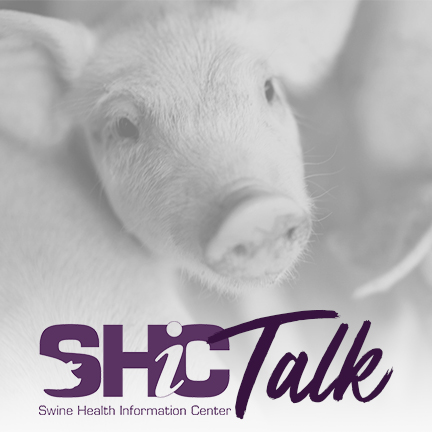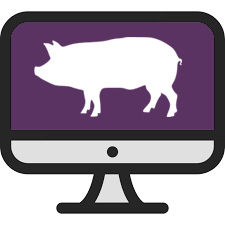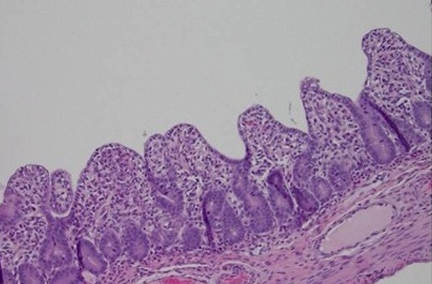
As the world deals with the COVID-19 pandemic, SHIC continues to focus efforts on prevention, preparedness, and response to novel and emerging swine disease for the benefit of US swine health. As a conduit of information and research, SHIC encourages sharing of its publications and research. Forward, reprint, and quote SHIC material freely. SHIC is funded by America’s pork producers to fulfill its mission to protect and enhance the health of the US swine herd. For more information, visit https://www.swinehealth.org or contact Dr. Sundberg at [email protected].

Episode 4 of SHIC Talk, the Swine Health Information Center’s podcast, is now live. Join host Barb Determan as she talks with SHIC Executive Director Dr. Paul Sundberg, National Pork Producers Council Chief Veterinarian Dr. Liz Wagstrom, and National Pork Board Chief Veterinarian Dr. Dave Pyburn. They discuss on-going African swine fever (ASF) research in Vietnam, why it’s important, and how it will benefit the US pork industry.

The Swine Health Information Center (SHIC) is again joining with the American Association of Swine Veterinarians (AASV) to sponsor a webinar on a timely swine health issue. On December 10, 2020, from 10:00 to 11:30 am, a webinar on astrovirus type 3 will feature Dr. Kayla Henness, The Maschhoffs, Dr. Fabio Vannucci, University of Minnesota, and Dr. Bailey Arruda, Iowa State University. This virus has recently been associated with neurological signs like hind limb weakness, posterior paraplegia, quadriplegia, convulsions, and flaccid paralysis of muscles at an increased frequency by veterinary diagnostic labs. These experts will be providing their first-hand perspective about signs and management on the farm and best practices for diagnostics. Because astrovirus type 3 is difficult to diagnose, with the need for the right tissues collected the right way for submission, and difficult to manage, the webinar will provide resources for undiagnosed issues producers and practitioners may be seeing.
During the webinar, Dr. Henness will share an astrovirus type 3 case overview including management design, strategies, and interventions. Dr. Vannucci will discuss clinical presentation, diagnostic testing, and best practices as well as share a diagnostic lab summary. Dr. Arruda will share case summaries, protocol and sampling guidelines, along with strategies and complications with diagnostics.
These webinars bring together subject matter experts to discuss current issues facing US pork producers and practitioners. Past topics have included viral myelitis, tracheitis, coccidiosis, and lameness/arthritis. Conducted by the Iowa State University Swine Medicine Education Center (SMEC), webinar participants include practitioners with first-hand experience with the topic being discussed, diagnosticians, and other experts. Completed webinars are posted online for convenient access here.
With almost all industry meetings either canceled or gone virtual, the opportunity to talk in person with colleagues about issues affecting health has diminished greatly. So having a new opportunity for conversation is helpful. Do you have a recommendation for a topic to be addressed in this format? SHIC and AASV would like your input! Reach out to SHIC Executive Director Dr. Paul Sundberg at [email protected] or AASV Director of Public Health and Communications Dr. Abbey Canon at [email protected] with your webinar recommendations.

In 2019, the Swine Health Information Center (SHIC), with active support from the National Pork Producers Council (NPPC), received a grant from USDA’s Foreign Agricultural Service division to fund a multi-phase project including African swine fever (ASF) field projects in Vietnam during the outbreak there. Objectives of these researchable priorities are helping Vietnamese response and recovery from the ASF epidemic as well as helping US pork producers learn lessons about ASF epidemiology and management. Despite challenges presented by the COVID-19 pandemic, progress continues on each of the related projects.
The USDA grant, “Building capacity to support the control of African Swine Fever (ASF) in Vietnam,” has two sections. One section, “Implementation of field projects, and collection and analysis of samples,” will help with industry preparedness and response in Vietnam and should ASF reach the U.S. Project topics and objectives follow.
ELISA
Two related projects include evaluating the performance of ASF serum and/or oral fluid ELISAs for use in the surveillance and monitoring of ASF outbreaks in commercial farms in Vietnam and in preparation for the virus becoming endemic in the US. More broadly, fulfillment of these projects will support a comprehensive integrated swine surveillance system (“no single best diagnostic approach”) that takes advantage of a combination of molecular and antibody methods.
Rodents
This project will study if ASF virus can be detected in, or on, mice and rats on farms with ASF outbreaks, and if so, which tissues are the best to sample. In addition, research will look at the effectiveness of farms’ biosecurity level on rodents’ ability to bring in the disease onto the farm. Another project element will measure mouse-to-mouse transmission of ASF in a controlled laboratory situation.
Baking for Disinfection
Determining the optimal baking time and temperature required to completely inactivate ASF on aluminum surfaces contaminated with organic materials, this project is designed to simulate the sanitation protocols currently used to disinfect animal trailers.
Epidemiological Analysis of Pathways of Entry
With the rapid response outbreak survey of SHIC’s Rapid Response Program, this project will identify likely pathways of ASF entry onto farms as well as test an electronic format for completing the outbreak investigation forms. The information can be used to improve on-farm biosecurity and streamline the process for US outbreak investigations, if or when they are needed as the US would start an eradication program.
In 2019, the Swine Health Information Center (SHIC), with active support from the National Pork Producers Council (NPPC), received a grant from USDA’s Foreign Agricultural Service division to fund a multi-phase project including African swine fever (ASF) field projects in Vietnam during the outbreak there. Objectives of these researchable priorities are helping Vietnamese response and recovery from the ASF epidemic as well as helping US pork producers learn lessons about ASF epidemiology and management. Despite challenges presented by the COVID-19 pandemic, progress continues on each of the related projects.
The USDA grant, “Building capacity to support the control of African Swine Fever (ASF) in Vietnam,” has two sections. One section, “Implementation of field projects, and collection and analysis of samples,” will help with industry preparedness and response in Vietnam and should ASF reach the U.S. Project topics and objectives follow.
ELISA
Two related projects include evaluating the performance of ASF serum and/or oral fluid ELISAs for use in the surveillance and monitoring of ASF outbreaks in commercial farms in Vietnam and in preparation for the virus becoming endemic in the US. More broadly, fulfillment of these projects will support a comprehensive integrated swine surveillance system (“no single best diagnostic approach”) that takes advantage of a combination of molecular and antibody methods.
Rodents
This project will study if ASF virus can be detected in, or on, mice and rats on farms with ASF outbreaks, and if so, which tissues are the best to sample. In addition, research will look at the effectiveness of farms’ biosecurity level on rodents’ ability to bring in the disease onto the farm. Another project element will measure mouse-to-mouse transmission of ASF in a controlled laboratory situation.
Baking for Disinfection
Determining the optimal baking time and temperature required to completely inactivate ASF on aluminum surfaces contaminated with organic materials, this project is designed to simulate the sanitation protocols currently used to disinfect animal trailers.
Epidemiological Analysis of Pathways of Entry
With the rapid response outbreak survey of SHIC’s Rapid Response Program, this project will identify likely pathways of ASF entry onto farms as well as test an electronic format for completing the outbreak investigation forms. The information can be used to improve on-farm biosecurity and streamline the process for US outbreak investigations, if or when they are needed as the US would start an eradication program.

The swine industry understands the epidemiology of porcine epidemic diarrhea virus (PEDv) and porcine reproductive and respiratory syndrome virus (PRRSv) better than ever. Still, the ability of producers to effectively estimate spatial and temporal variation in disease outbreak risk is lacking. By using data contributed by the Morrison Swine Health Monitoring Project (MSHMP), researchers at the University of Minnesota (UMN) built machine learning algorithms that predict whether a sow farm will break with PEDv two weeks in advance.
This research project intended to generate farm-level forecasts of PEDv risk, considering recent animal movements, present disease distribution, and environmental factors. Producers will benefit from anonymously reported information from others in the region to better understand their farms’ risk. Once a farm is flagged with a high probability, systems and veterinarians can enact prevention and response measures to better navigate an outbreak, minimizing its impact. This work was partially funded by the Swine Health Information Center (SHIC).
The UMN-developed forecasting tool was able to detect approximately 20% of the outbreaks in a region (sensitivity), while 70% of the outbreaks the tool said would occur did indeed happen (positive predictive value).The most important factors related to a higher predicted risk of an outbreak were animal movements both into the sow farm and its neighbors, as well as the PED-status of the origin farm of these movements. Farm density and ambient temperature were also important predictors. Given information from the tool, how could producers react? Informing on-farm staff of predicted risk, review of training protocols, ensuring biosecurity adherence, changing pig flow, stocking adequate supplies for treatment, and preparation for higher mortality were listed by producers as possible responses to elevated risk.
UMN developed this tool using data for a single US swine-dense region and began applying it to a second region of the country, operating with different industry systems and a different environment. This forecasting tool is ready for real-time use; since December 2019, contributing systems have received weekly system-specific predictions of PEDv outbreak risk at farm level. These predictions are made two weeks into the future, which allows systems, veterinarians, and producers to act in case a high probability of an outbreak is forecasted. This provides an important tool for informed decision-making and coordinated actions of producers and practitioners to control or mitigate the impact of PEDv outbreaks.
In the long term, benefits to the pork industry may be more substantial. The forecasting tool was built to be able to handle different diseases, given that enough information on their occurrence is entered. As such, this tool presents a unique opportunity to face challenges the industry may encounter, even in the case of the introduction of foreign animal diseases in the US swine herd. Further development may be needed to ensure important aspects of the transmission of those diseases are adequately being entered in the model (such as the issue with strains/lineages/RFLPs for PRRSv), but the operationalization of this project puts the US industry in better spot to fight these challenges that may emerge.

The US pork industry remains vulnerable to the introduction of a variety of foreign animal and production diseases. The Swine Health Information Center (SHIC) recognized the importance of developing systems to provide international situational awareness in near-real time for these pathogens, and funded a near real-time Global Swine Disease Monitoring Report (GSDMR) system to collect and disseminate this information. In particular, the project has tracked the expansion of African swine fever (ASF) through Asia and Europe. And a new “Focus on…” section will raise awareness about specific international swine disease risks. The GSDMR project was recently reviewed by SHIC and funding renewed so it will continue through 2021.
Launched in December 2017, more than 50 GSDMRs have contributed valuable data to industry stakeholders as diseases such as ASF, classical swine fever (CSF), and foot-and-mouth disease (FMD) have impacted other countries. The new element of the reports, “Focus on…” provides comprehensive snapshots of current knowledge of swine infectious diseases throughout selected regions. It will soon be available online in the format of dashboards updated regularly.
To create the reports, the team at the University of Minnesota has developed a private-public-academic partnership to support a system for near real-time identification of hazards that will contribute to the mission of assessing risks to the industry. Identified hazards are scored using a step-wise procedure of screening, to identify emerging infectious diseases that, potentially, may represent a risk for the US swine industry. A combination of soft and official data is actively and passively collected then organized.
Following successive screening steps in which data and information were synthesized, edited, corrected, and expanded in collaboration with selected stakeholders, a report describing the outputs has been available on a routine basis. In addition to the three USDA-classified tier 1 reportable foreign animal disease of swine (ASF, CSF, and FMD), reports for significant changes in the epidemiological situation of production diseases such as porcine reproductive and respiratory syndrome (PRRS) and pseudorabies disease (PRV), have also been included.
GSDMRs are available on the SHIC website (https://www.swinehealth.org/global-disease-surveillance-reports/) and are included in the organization’s monthly enewsletter.
As the world deals with the COVID-19 pandemic, SHIC continues to focus efforts on prevention, preparedness, and response to novel
and emerging swine disease for the benefit of US swine health.

This month’s Domestic Swine Disease Monitoring Report shows porcine reproductive and respiratory syndrome virus (PRRSV) detection was on the upper boundaries of the forecasted model at the end of October and beginning of November, mostly from a substantial increase in detection from wean-to-market animals. During November, a moderate increase in PRRSV detection in the age category adult sow farm was observed. The October detection levels for porcine epidemic diarrhea virus (PEDV), porcine deltacoronavirus (PDCoV), and Mycoplasma hyopneumoniae (MHP) were similar from October. At a state level, PRRSV detection was three standard deviations above expected in Minnesota, Iowa, South Dakota, Nebraska, Missouri, and Indiana. A seasonal increase in the number of disease diagnosis for PRRSV, Influenza A, S.suis, G.parasuis, B. bronchiseptica, and P. multocida was detected. In the podcast, the SDRS hosts talk with Dr. Clayton Johnson, of Carthage Veterinary Services, about his experiences in using and applying veterinary diagnostic data for disease management and control.

The November 2020 Global Swine Disease Monitoring Report includes information on the first case of African swine fever (ASF) reported in the Saxony region of Germany. As a result, a new third restriction zone in the state, which is bordered by Brandenburg to the south, has been established. In South Korea, new ASF outbreaks in domestic pigs almost a year after the last report were discovered. ASF was detected in Russian pork products in several regions of that country. Porcine reproductive and respiratory syndrome virus (PRRSV) is an emergent issue in Russia with authorities there updating preventive and control guidelines.
Copyright 2024 | Swinehealth.org | Website by Heartland Marketing Group